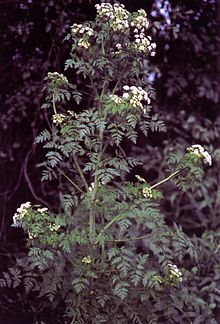| Conium maculatum | |
|---|---|

| |
| Conium maculatum in California | |
| Scientific classification | |
| Kingdom: | Plantae |
| Clade: | Tracheophytes |
| Clade: | Angiosperms |
| Clade: | Eudicots |
| Clade: | Asterids |
| Order: | Apiales |
| Family: | Apiaceae |
| Genus: | Conium |
| Species: | C. maculatum
|
| Binomial name | |
| Conium maculatum L., 1753
| |
| Synonyms[1] | |
|
List
| |
Conium maculatum, known as hemlock (British English),[2] or poison hemlock (American English)[3] is a highly poisonous flowering plant in the carrot family Apiaceae, native to Europe and North Africa. It is herbaceous without woody parts and has a biennial lifecycle. A hardy plant capable of living in a variety of environments, hemlock is widely naturalised in locations outside its native range, such as parts of Australia, West Asia, and North and South America, to which it has been introduced. It is capable of spreading and thereby becoming an invasive weed.
All parts of the plant are toxic, especially the seeds and roots, and especially when ingested. Under the right conditions the plant grows quite rapidly during the growing season and can reach heights of 2.4 metres (8 feet), with a long penetrating root. The plant has a distinctive odour usually considered unpleasant that carries with the wind. The hollow stems are usually spotted with a dark maroon colour and become dry and brown after completing its biennial lifecycle. The hollow stems of the plant are deadly for up to three years after the plant has died.[4]
- ^ Allkin, R.; Magill, R.; et al., eds. (2013). "Conium maculatum L." The Plant List (online database). 1.1. Retrieved January 23, 2017.
- ^ Cite error: The named reference
BSBI Atlaswas invoked but never defined (see the help page). - ^ Cite error: The named reference
USDAwas invoked but never defined (see the help page). - ^ Duggan, Scott (2018-06-01). "Poison hemlock and Western waterhemlock: deadly plants that may be growing in your pasture". Ag - Forages/Pastures.
